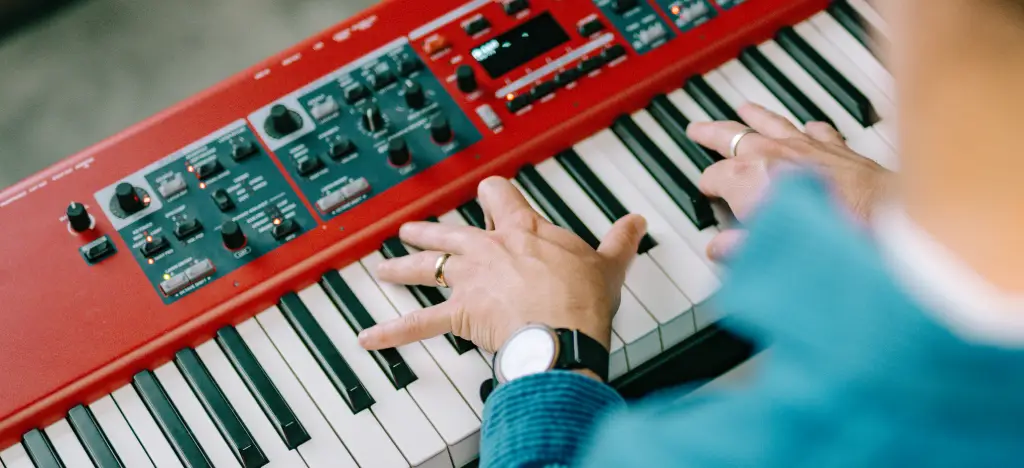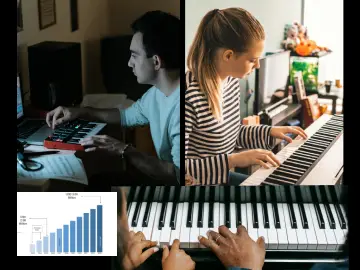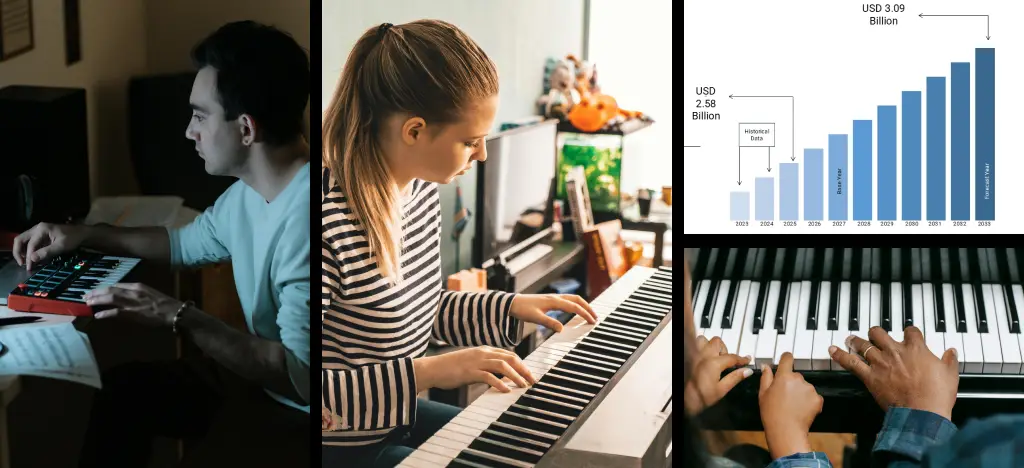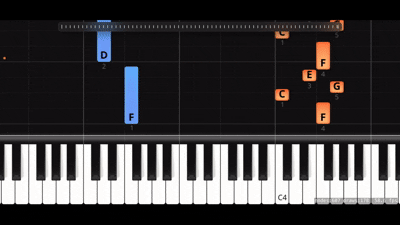Your neighbour’s bought a compact keyboard. Your friend just posted their first TikTok cover. Your mum’s finally learning the song she always wished she could play. Piano is back in living rooms, on stages, and in people’s hands everywhere. This isn’t a niche revival. It’s a genuine boom, the biggest surge in people learning piano since the 1980s, fuelled by affordable keyboards, mobile apps, AI piano teachers, and a hunger to actually make music in a world of passive listening.
- When every house seemed to have a piano
- Why piano is making a comeback
- Why digital pianos are more popular than ever
- How piano thrives in the age of TikTok and Instagram
- Health, wellness, and the mindful instrument
- Learning piano in modern life
- Learn a song on piano for free
- FAQs: Learning piano in 2025
When every house seemed to have a piano
If you grew up in the 1980s (which I did), you’ll probably remember a house somewhere on your street that had a piano in the front room. Sometimes it was a polished upright, sometimes a Yamaha or Casio keyboard that felt futuristic with its demo songs and plastic buttons. Back then, learning piano was almost a rite of passage. And for a while, it seemed like everyone was taking lessons.
By the mid-1990s, though, the guitar had stolen the cultural spotlight. Grunge, Britpop, nu-metal, and indie bands were built on power chords, not piano chords. The keyboard lingered in the background: still essential for classical music and theory, but not the instrument kids wanted to learn. The 2000s pushed things further — why learn piano when music software and beat-making apps could do the work in minutes?
And yet here we are in 2025, with a resurgence. More people are learning piano today than at any time since that 1980s boom. It’s not just nostalgia. Affordable keyboards, online piano lessons, and even AI piano teachers have made the instrument relevant again — and players of every generation are coming back to it.
💡 ARTMASTER TIP: Curious what learning with AI piano teacher feels like? Meet Artie. This is his free play mode where Artie listens as you play and gives instant feedback — just like a real teacher. Join the waitlist for early access
Why piano is making a comeback
It would be neat to call the current piano boom sudden, but really it’s been years in the making. Interest in learning piano has been rising steadily for more than a decade. Pop culture played its part — from Alicia Keys bringing the instrument’s soulful sound back to the charts, to YouTube in the 2010s, where teenagers pulled in millions of views with bedroom covers of Adele and other piano ballads.
The real turning point, though, came after 2020. During lockdowns, millions looked for hobbies that were both creative and calming. Streaming and gaming filled some hours, but learning an instrument felt more rewarding — and piano, with its instant accessibility (“press a key and it makes a sound”), became the obvious choice. Sales of digital pianos and keyboards spiked worldwide, and demand for online piano lessons surged. That surge never really faded — it set the stage for today’s revival.
💡 ARTMASTER TIP: Part of what kept the piano in people’s minds through those years were unforgettable songs. If you want a reminder of just how powerful a single riff can be, check out 40 of the most iconic piano intros ever recorded.
Why digital pianos are more popular than ever
 Ironically, it is the same digital tech that once threatened the piano’s place has now fuelled its revival. The latest digital pianos and keyboards aren’t the heavy, clunky machines of the 1990s. They’re light, portable, and far cheaper than the big uprights of the past. A decent weighted 88-key digital piano can cost under £500, and a compact 61-key keyboard can be picked up for much less.
Ironically, it is the same digital tech that once threatened the piano’s place has now fuelled its revival. The latest digital pianos and keyboards aren’t the heavy, clunky machines of the 1990s. They’re light, portable, and far cheaper than the big uprights of the past. A decent weighted 88-key digital piano can cost under £500, and a compact 61-key keyboard can be picked up for much less.
Add to that the rise of learning apps, YouTube tutorials, and AI teaching tools, and suddenly piano doesn’t feel intimidating. You don’t need to read sheet music or hire a teacher from day one. You can start with chord symbols, falling-block notation, or just copying someone else’s hands on a screen. That shift in accessibility has been transformative.
One sign of the trend: Roland, Yamaha, and Casio all reported growth in their digital piano sales in 2023 and 2024, particularly in the portable range. Korg’s Liano (weighing just 6kg) became a bestseller precisely because people wanted something slim enough to move around the house. Portability has gone from a nice-to-have to a central selling point.
💡 ARTMASTER TIP: Wondering if a compact keyboard is enough to start on, or if a piano makes more sense? Our guide to choosing between them walks you through the options.
How piano thrives in the age of TikTok and Instagram
 Another big factor: piano has become social again. A generation raised on TikTok and Instagram doesn’t just want to practise for themselves — they want to share progress. Clips of beginners managing their first song, or pianists putting their twist on a hit, rack up likes quickly. Unlike guitar, where a half-learned riff can sound rough, piano has a way of sounding musical even when you’re just starting out.
Another big factor: piano has become social again. A generation raised on TikTok and Instagram doesn’t just want to practise for themselves — they want to share progress. Clips of beginners managing their first song, or pianists putting their twist on a hit, rack up likes quickly. Unlike guitar, where a half-learned riff can sound rough, piano has a way of sounding musical even when you’re just starting out.
And it’s not just about showing off performance. Social platforms have turned piano into a soundtrack too — the instrument is everywhere in short-form videos, underscoring emotional stories, adding drama to memes, or providing the background for everything from travel reels to breakup posts. Even when the player isn’t on screen, piano music has become part of the visual language of social media.
That’s given it a unique advantage in the social media age. Piano is both a solitary practice tool and a performance instrument. It works as a quiet escape and as content fuel. For many new learners, the two motivations overlap.
💡 ARTMASTER TIP: Social media exposure is also reshaping what musicians need to know. Find out the modern essentials, from AI tools to content strategy, in our guide: The new essentials: What every musician should learn in 2025.
Health, wellness, and the mindful instrument
 There’s also a deeper reason for piano’s comeback. As awareness of mental health has grown, more people have been looking for activities that balance focus with relaxation. Piano is almost tailor-made for that. It requires concentration, but it doesn’t feel like a grind in the way learning scales on a violin might. It engages the brain in problem-solving and memory, but in a way that feels expressive and rewarding.
There’s also a deeper reason for piano’s comeback. As awareness of mental health has grown, more people have been looking for activities that balance focus with relaxation. Piano is almost tailor-made for that. It requires concentration, but it doesn’t feel like a grind in the way learning scales on a violin might. It engages the brain in problem-solving and memory, but in a way that feels expressive and rewarding.
Studies have linked learning piano with improvements in cognitive function, stress reduction, and even better sleep. It’s no coincidence that adult learners — many of whom gave up lessons as children — are coming back in their 30s, 40s, and 50s, treating the piano as both a hobby and a form of self-care.
💡 ARTMASTER TIP: Playing piano isn’t just fun — it’s good for your brain and body. Learn more about the ways music empowers your mental and physical health in our article, How learning music benefits the brain and body.
Learning piano in modern life
People are fitting piano into modern lifestyles — playing on slimline keyboards, learning online or using apps, recording at home, and sharing progress digitally.
It’s a revival shaped by technology, but driven by something timeless: the piano’s ability to feel both immediate and infinite. You can press one key and make music, or you can spend a lifetime exploring. In an era of constant distraction, that combination has never felt more appealing.
💡 ARTMASTER TIP: Thinking about learning piano yourself? Check out our other articles:
→ The best piano learning apps (I tried them so you don’t have to)
→ What are the best online piano lessons in 2025?
→ How much do music lessons really cost?
and try learning these simple piano songs (chord diagrams included):
→ 25+ easy two-chord songs
→ 60+ easy 3-chord songs
→ 100+ four-chord songs
→ 20 beginner-friendly songs to learn on piano
The piano revival isn’t slowing down — and with tools like Artie on the horizon, it’s about to get even more exciting. Join the waitlist here to see how AI can reshape the way you learn.
Learn a song on piano for free
FAQs: Learning piano in 2025
Is piano really making a comeback?
Absolutely. More people are learning piano now than at any point since the ’80s, thanks to affordable keyboards, online lessons, and AI teachers.
Keyboard or piano — which is better to start with?
Keyboards are cheaper and portable, pianos give you the “real” feel. For most beginners, a digital piano with weighted keys is the sweet spot. Here’s our guide.
Do I need to read music?
No. Apps, videos, and AI tools mean you can learn with chords, falling-block notation, or just by watching someone else play.
How fast can I learn a song?
Faster than you think. With regular practice, most beginners can play a simple tune in a week.
Does piano help with stress?
Yes. Playing is proven to lower stress, improve focus, and boost memory. Many adults return to piano as a form of self-care. See more benefits here.
What’s the best way to start?
Use whatever keeps you playing — a compact keyboard, a favourite app, or an AI teacher like Artie. The key is consistency.
About the author
Matt Ford is a musician, teacher, writer, and lifelong student of sound.
With years of experience in both performing and teaching, he shares practical advice through ArtMaster to help musicians at every level build skill and confidence in their playing.




